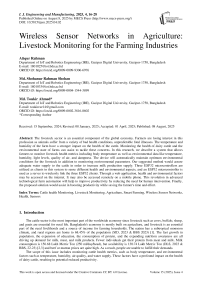Wireless Sensor Networks in Agriculture: Livestock Monitoring for the Farming Industries
Автор: Atiqur Rahman, Md. Shohanur Rahman Shohan, Md. Toukir Ahmed
Журнал: International Journal of Engineering and Manufacturing @ijem
Статья в выпуске: 4 vol.15, 2025 года.
Бесплатный доступ
The livestock sector is an essential component of the global economy. Farmers are losing interest in this profession as animals suffer from a variety of bad health conditions, unpredictable fatal illnesses. The temperature and humidity of the farm have a stronger impact on the health of the cattle. Monitoring the health of dairy cattle and the environmental state of farms can assist to tackle these concerns. In this research, we describe a system that allows farmers to monitor livestock health metrics including body temperature as well as environmental data like temperature, humidity, light levels, quality of air, and dampness. The device will automatically maintain optimum environmental conditions for the livestock in addition to monitoring environmental parameters. Our suggested method would assure adequate water supply to the cattle in order to increase milk production supply. Three ESP32 microcontrollers are utilized as clients in this system to sense different health and environmental aspects, and an ESP32 microcontroller is used as a server to wirelessly link the three ESP32 clients. Through a web application, health and environmental factors may be accessed on the internet. It may also be accessed remotely on a mobile phone. This revolution in advanced technological farm automation will help to improve productivity by reducing the need for human intervention. Finally, the proposed solution would assist in boosting productivity while saving the farmer's time and effort.
Cattle health Monitoring, Livestock Monitoring, Agriculture, Smart Farming, Wireless Sensor Networks, Health, Sensors
Короткий адрес: https://sciup.org/15019868
IDR: 15019868 | DOI: 10.5815/ijem.2025.04.02
Текст научной статьи Wireless Sensor Networks in Agriculture: Livestock Monitoring for the Farming Industries
The scope of this issue includes monitoring cattle health metrics, such as body temperature, and environmental factors such as temperature, humidity, air quality, and water supply. These factors have a profound impact on the health of dairy cattle, resulting in potential reduced productivity.
Diseases like pneumonia and foot and mouth disease are becoming more frequent, and environmental stressors such as elevated humidity and temperatures exacerbate them. That is how dire these issues are. The financial toll is enormous, because productivity decreases and livestock medical bills go up.
The reliability of sensor data, the lack of controlled real-time monitoring systems, the difficulty of maintaining ideal environmental conditions for livestock, the limited automation of farms for vital tasks like lighting and water supply, and the high implementation costs of these technologies particularly on small farms are some of the specific challenges. Improving livestock productivity and general health requires addressing these issues.
Livestock's Gross Domestic Product (GDP) Contribution (Constant Prices) is 1.90% (BBS,22-23) [3]. Besides, Bangladesh offers a favorable environment for cattle. As a result, the need to boost the dairy business, particularly in rural regions, has been identified. Furthermore, 39% of Bangladesh's educated unemployed (BBS, 2016) [3] are people who can eliminate unemployment by establishing farms. Bangladesh imports 120 000 metric tons of powdered milk (BDFA, 2016-17) [4].
Although the dairy sector is the oldest profession in Bangladesh's rural areas, its development has not been satisfying owing to a number of issues. For dairy cows to produce more milk, an adequate amount of grain must be provided, and their welfare must be maintained. But a number of factors, including different illnesses, the temperature and humidity of the environment and the cattle's bodies, the availability of clean water, the amount of light, and other factors, have an impact on the success of the dairy business. Additionally, cattle are afflicted with a number of diseases, including infectious bovine abortion, mastitis, anthrax, and black-quarter (or "black-leg"). Body sensors and wearable technologies are becoming more and more important in animal healthcare systems.
A wireless sensor network (WSN) is an ad-hoc system made up of several tiny, cheap devices. In order to measure and gather data on numerous factors linked to bovine body temperature, environmental temperature and humidity, farm light levels, floor moisture, etc., sensors can regularly monitor the activities of cattle and farms. Due to the recent breakthroughs in the domain of Internet of Things (IoT), Wireless Sensor Networks in Agriculture: Livestock Monitoring for the Farming Industries are currently employed to avoid the limitations of traditional WSN. Traditional livestock monitoring techniques entail manual supervision, which involves a lot of skilled labor and time. Additionally, typical WSN just keeps an eye on the farm or animals. In light of this, Livestock Monitoring for the Farming Industries remotely monitors both livestock and farms in addition to carrying out numerous automated actuations by analyzing the data. Whereas this approach increases the milk output of the dairy farm while decreasing labor expenses and time. The major contributions of this paper are compiled below.
• We devised and constructed a system that can detect many environmental characteristics such as temperature, humidity, air quality, light intensity, floor wetness, and so on, as well as execute autonomous actuation depending on the data.
• Our constructed system automatically gives adequate fresh water to animals, resulting in increased milk production.
• We have also designed and developed our system based on WSN where all modules are communicated to the server wirelessly.
• Our developed web dashboard will let farmers keep track of environmental factors and animal body temperature remotely.
• Furthermore, we used a simulation environment to illustrate the effectiveness of the proposed system.
2. Related Work
Rest of the paper is arranged as follows. Section 2 gives a summary of some previous research activities related to assisting cattle and farm monitoring as well as describing their research gaps also. Section 3 describes the methodology with the overall workflow of the study in detail. Section 4 presents the experimental results and discussion. Finally, section 5 contains the conclusion and future work of the paper.
The cattle health monitoring and GPS position tracking system proposed by Intan et al. [5] combines nRF24L01+PA+LNA, IoT, ESP32, GPS, and DHT11 sensors to monitor body temperature, ambient temperature, and humidity. Although their approach mainly focused on addressing the lack of agricultural surveillance and automation technologies, it did not provide answers for improving operational efficiency or including a recommender system. Lavanya et al. [6] endeavored to enhance the early identification of agricultural concerns and increase revenue by employing LORA and infrared thermometer technologies for monitoring body temperature and ambient factors. Nevertheless, their proposal lacked a tangible implementation, therefore restricting the practical viability and thorough automation of farm monitoring. Ma et al. [7] conducted a study on the extended-term remote monitoring of cattle health and the early identification of abnormalities utilizing Wi-Fi, multi-agent systems, and sensors to measure environmental parameters such as temperature, humidity, illuminance, and migration distance. Notwithstanding the system's potential, it encountered difficulties related to heavy computing and communication expenses, which could impede its scalability and efficacy in extensive agricultural operations. The autonomous animal monitoring system developed by Arshad et al. [8] utilized wireless sensor networks (WSN) and Internet of Things (IoT) platforms. The system employed ESP8266
sensors to monitor various parameters like body temperature, humidity, heartbeat, air quality, CO2, and water levels. Although the system is extensive, it did not include mechanisms for monitoring moisture, which can potentially impact the overall efficacy of health monitoring. Duraisamy et al. [9] developed an intelligent calf health monitoring system utilizing Arduino and IoT sensors to quantify body temperature, humidity, pulse rate, respiration rate, and rumination (rumination). Nevertheless, the system lacked functionality for agricultural surveillance, therefore restricting its capacity to provide comprehensive farm monitoring and automation. The IoT-based animal health monitoring system created by Mrunal et al. [10] utilizes ZigBee, LM35, accelerometers, GPS, ARM7 LPC 2138, and IoT technology to monitor body temperature, acceleration, and position. The lack of thorough tracking of the farm environment significantly undermined the accuracy of the system, therefore restricting its capacity to identify environmental elements that impact the health of animals. An IoT-based cow monitoring their health system was developed by Unold et al. [11] to monitor body temperature, heartbeat, and rumination using dedicated IoT sensors. Unfortunately, their method lacked the integration of farm environment monitoring, which consequently diminished the precision in evaluating livestock health comprehensively. In order to enhance milk production, Mhatre et al. [12] devised an Internet of Things (IoT) system for dairy cows. This system utilized Arduino and IoT sensors to monitor several physiological parameters such as body temperature, humidity, heartbeat, and rumination. The system's capabilities were constrained by the absence of a unified wearable device and the lack of farm monitoring, which impeded the collection of complete data for the purpose of optimizing farm management. Satyaprakash et al. [13] investigated machine learning models for the prediction of cattle illnesses using pertinent specifications. Nevertheless, their study was deficient in providing a comprehensive explanation of farm and cow health automation, therefore diminishing the practical relevance of their conclusions in operational farm settings. The non-invasive sensor technique for dairy calf health monitoring, which use ontology matching to monitor temperature and accelerometer data, was proposed by Awasthi et al. [14]. Nevertheless, the system failed to take into account heartbeat and ECG, and it did not incorporate monitoring of the farm environment, therefore restricting its overall usefulness in the management of cattle health. The Zigbee-based animal health monitoring system, designed by Anuj et al. [15], utilized the IEEE1451.1 and Zigbee technologies to monitor rumination, heart rate, temperature, and humidity. The system's accuracy was constrained by the lack of farm environment monitoring, therefore diminishing its efficacy in practical agricultural situations. Alberto et al. [16] integrated multi-agent systems and wireless sensor networks to monitor cattle, specifically targeting heat detection, calving time, and feed levels. Notwithstanding its potential, the system incurred substantial computing and communication expenses, and it was deficient in monitoring the farm environment, hence requiring significant resources. The cow health monitoring system established by Agarwal et al. [17] utilized WPAN and LabVIEW as data loggers, in accordance with the IEEE1451.1, 1451.2, and 802.15.4 standards. The system recorded body temperature, perspiration, pulse, and rumination, but its precision was constrained by the lack of monitoring of the farm environment. Sharma et al. [18] conducted a study on the monitoring of cattle health utilizing wireless sensor networks (WSN) and biosensors to quantify body temperature, humidity, heart rate, and ventilatory activity. Despite monitoring the physical status of cattle, it failed to consider the surrounding environment, therefore affecting comprehensive health management. The cow health and environment monitoring system proposed by Aswini et al. [19] use Arduino and biosensors to detect several parameters like body temperature, heartbeat, ambient temperature, humidity, and motor activity. Although the system monitored both livestock and the environment, it did not require any actuators, which restricted the extent of farm automation. Faruq et al. [20] created a health monitoring and early disease detection system for dairy cows by utilizing the Internet of Things (IoT) and IEEE 802.11 standards to quantify temperature and heart rate. Notwithstanding the system's potential, it was intricate, had substantial cost consumption, and lacked systematic monitoring of the farm environment, therefore compromising its overall usefulness. The smart cattle health monitoring system developed by Duraisamy et al. [21] use Arduino and IoT sensors to monitor various physiological parameters like body temperature, humidity, heartbeat, respiration, and rumination. The lack of farm monitoring greatly diminished the precision and overall efficiency of the system. Kae et al. [22] introduced a novel cow monitoring system for agricultural sectors that utilizes wireless sensor networks (WSN) with ISM and RIP protocols to track the movement of animals. The system exclusively concentrated on monitoring mobility, neglecting other crucial health and environmental aspects. The Arduino and LabVIEW-based cow health monitoring system for early disease diagnosis, monitoring body temperature, respiration, humidity, heartbeat, and rumination was created by Swain et al. [23]. The level of precision of the system was constrained by the lack of monitoring of the farm environment. The cow health monitoring system proposed by Park et al. [24] use Zigbee technology and biosensors to quantify cardiovascular activity, respiratory rate, and biomechanical motion. The system's precision was undermined by the absence of extensive monitoring of the farm environment, therefore diminishing its overall effectiveness for comprehensive health management. Kharde et al. [25] created a sophisticated calf health monitoring system utilizing Arduino and IoT to track parameters such as rumination, heart rate, temperature, respiration, and humidity. Notwithstanding its advantages, the system exhibited reduced accuracy owing to the lack of monitoring of the farm environment. In their study, Shinde et al. [26] developed an animal health monitoring system based on the Internet of Things (IoT). The system utilized Naive Bayes classification and IEEE 802.11 in conjunction with IoT sensors to monitor body temperature, humidity, and heart rate. The system insufficiently included monitoring and administration of the farm environment, thereby restricting its overall usefulness. A livestock monitoring system was created by Nkwari et al. [27] utilizing wireless sensor networks (WSN) and employing the IEEE 802.15.4 and Zigbee standards. The system exclusively tracked cattle, disregarding farm environment variables, therefore diminishing its effectiveness in comprehensive farm management. Shinde et al.
[28] introduced a wireless system that utilises Arduino controllers to monitor the physiological characteristics of cattle, specifically cardiac rate. The system was dependent on manual monitoring and lacked comprehensive monitoring of the farm environment, therefore restricting its automation and scalability. Suresh et al. [29] developed an Internet of Things (IoT)-based animal health monitoring system that utilises IoT and Time-Domain Multiple Access (TDMA) to quantify body temperature, heart rate, and humidity. The implementation of TDMA resulted in an enhanced end-to-end delay, but the system was deficient in monitoring the farm environment, thereby constraining its overall efficiency.
3. Methodology3.1 Material
A significant number of current livestock health monitoring systems [5-29] are missing essential capabilities for thorough farm management. However, [5,6,8] did not use automated decision-making or recommender systems to improve operational efficiency in their suggested systems for monitoring cattle health utilizing IoT and wireless technologies. The long-term monitoring systems [7,16] encountered significant computational and communication expenses, which could hinder their scalability, particularly in the context of larger farms. Furthermore, a majority of the systems [5-7,9-12,15-25] did not include the incorporation of real-time monitoring of the farm environment. This limitation undermined the precision of health evaluations as they failed to consider external elements that might impact agricultural health. Although many publications focused on the physical characteristics of animal bodies, they often overlooked some aspects of the farm environment that have a direct or indirect impact on animal welfare. Specifically, the temperature and humidity of farms have a substantial impact on animals. Furthermore, the moisture content and illumination levels of the farm's floor have a direct influence on milk production, animal development, and the management of major diseases. Provision of sufficient water is essential for the production of milk. Our technology has undergone comprehensive testing using all the necessary components required to uphold animal well-being and enhance the output of meat and milk. Many systems fail to consider these crucial features [5-29]. Regardless the proposals [14,17,18] for monitoring systems that utilize wireless sensor networks (WSN) and biosensors to measure parameters such as temperature, humidity, and heart rate, the lack of farm environment monitoring presented a limitation to their systems. This exclusion diminishes the comprehensive suitability of the system for agricultural land management. Moreover, although systems such as those [15,23] utilized contemporary wireless protocols like ZigBee and IEEE standards, their efficacy in enhancing cattle health and farm productivity was diminished due to the absence of extensive real-time farm monitoring and automated decision technology. Systematic approaches such as those [20,22] mostly concentrated on tracking movement and monitoring health. However, these systems failed to consider environmental factors, which are essential for a comprehensive comprehension of cattle welfare.
To bridge these knowledge gaps, our proposed systems should prioritize the integration of cattle health and farm environment monitoring, real-time data processing, and automated responses. This will enable the development of costeffective, low-power, sustainable, and user-friendly solutions for widespread implementation in agriculture, as well as intelligent decision support systems for optimized farm management.
Livestock on the farm are being impacted by numerous sorts of illnesses and farmers are suffering significantly. To prevent this, we suggest a health monitoring system that keeps track of both the physical health of each animal as well as the overall farm environment. The cattle are being fitted with sensors to measure each animal's body temperature. Dairy cows' typical body temperatures range from 38.5°C to 39.5°C. The health of the dairy cow is also more significantly impacted by the farm's temperature and humidity. Temperature, humidity, and other farm variables are thus continually monitored in order to avoid this. Additionally, the farm's light intensity and the lack of pure water have an impact on the milk production rate. The ESP32 transmits and receives data from the sensors in this system, which then adapts the system as necessary.
A series of low-cost, low-power systems on chip microcontrollers called ESP32 is equipped with dual-mode Bluetooth and Wi-Fi functionality. Filters, power amplifiers, low-noise receive amplifiers, RF baluns, integrated antenna switches, and power management modules are all included. It is used to send and receive data from the sensor. Additionally, it processes the collected sensor data. The processed data is wirelessly sent to the main system's IGM (Intel Galileo Microcontroller) using a radio frequency transmitter (RF Transmitter).
The cattle's body temperature is measured with the LM35. It gives output voltage in degrees (Celsius). No additional calibration circuitry is needed. The typical temperature for cattle is 38.5° to 39.5° Celsius [5]. The rate of milk production is correlated with temperature. In addition, illnesses including milk fever, poisoning, dyspepsia, influenza, foot and mouth disease are linked to body temperature. Therefore, taking a body temperature reading is crucial.
The data from the sensor modules which consists of temperature, humidity and air quality is wirelessly transmitted to the server using ESP32 microcontrollers. The data transfer makes use of Wi-Fi, ensuring communication in real time between the client module and the server. Once received, the backend server cleans up the data to remove noise or spikes. Filtering procedures must be used to ensure the accuracy and reliability of the data. The data is processed and entered into a database, where it is analyzed using predetermined cut-offs and algorithms to detect changes in the environment and/or health status of the animals. Using blue tooth technology, the data is transferred from the collar to a web dashboard after analysing password protected data which helps farmers to know the environmental parameters of their farms and health of their cattle based on real time information.
Choosing for the system were the the LM35, DHT22, and the MQ135 sensors because of their precision, economy, and system fit. Because of its inexpensive cost and accurate temperature readings, the LM35 is often used for internal temperature monitoring. Because of its great precision in measuring humidity as well as temperature, the DHT22 sensor is recommended for environmental monitoring. Because of its sensitivity and dependability in tracking air quality in agricultural settings, the MQ135 sensor was selected for dangerous gas detection—including ammonia and sulfide. These sensors offer a mix of cost, precision, and simplicity for incorporating into the system, so they were chosen above other models on the market.
The atmosphere on farms has a significant impact on the prevalence of many illnesses in dairy cows as well as their ability to produce milk. A DHT 22 sensor is used in this system to monitor the farm's external temperature and humidity levels. A temperature and humidity sensor complex with a calibrated digital signal output is a feature of the DHT 22 temperature and humidity sensor.
An LDR may be utilized in switching circuits that are triggered by light and dark as well as light-sensitive detector circuits since it is a resistance semiconductor. In perfect darkness, a photoresistor's resistance can reach several megaohms (M), but in complete light, it can reach just a few hundred ohms. Another element that influences milk production is the level of light inside farms. Using this technology, light levels are monitored.
Additionally, dampness is a crucial factor for dairy farms. It is connected to numerous illnesses, including the foot rod. We employed soil moisture sensors in this setup. It monitors the soil's water content and may be used to calculate how much water is being stored in the soil horizon. Water in the soil is not immediately measured by soil moisture sensors. Instead, they track changes in another soil characteristic that is predictably connected to water content.
The MQ135 gas sensor can effectively monitor smoke and other dangerous gasses and has great sensitivity to ammonia gas, sulfide, and benzene series steam. It is a form of inexpensive sensor for many different applications and is capable of detecting many harmful gasses. In this system it is utilized for detecting and monitoring any sorts of harmful gasses in the farm environment that can damage the animals' health.
A dairy farm needs enough safe drinking water to increase milk output. The cause for the 6%–10% decreases in dairy production is the absence of a supply of safe drinkable water. Here, we utilized a water level sensor to make sure that there is always sufficient water in the tank.
The following block diagram Fig. 1. displays every component that is used in this system. The suggested system consists of four ESP32 microcontrollers, separate power supply, DHT22, LM35, LDR, soil moisture and water level sensors, a web application, and several more parts.

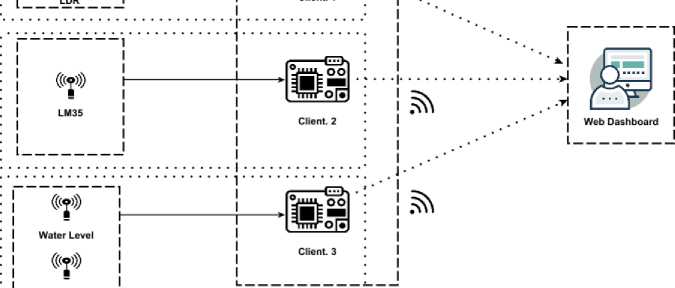
Soil Moisture |
WSN
Fig. 1. A Block Diagram illustrating the working flow of the proposed system.
Automation on the system is based on live sensor data. When humidity sensor (DHT22) senses that it is too low, the irrigation system will be triggered automatically to control water levels, and so on. Likewise, the light intensity sensor (one of the components for environmental monitoring) activates the lighting system when the light intensity is below a certain level, providing the cattle with a decent lighting environment. These functions happen automatically without the need for any manual processes, merely relying on a set parameter laid down in the system’s software to keep the farm environment steady for the health of livestock.
An administrative domain portion is combined by a server and three clients. Every client is using wireless technology to connect to the server. The ESP32 microcontroller is present in every client module. The Client. 1 microcontroller interacts with two sensors, the DHT22 and LDR. The data from the sensors, which include ESP32, is collected and sent to the server. The Client. 2 will also be connected to the cattle body in a similar manner. By using an LM35 sensor, it determines each animal's body temperature and transmits that information to the server module. Water level and soil moisture sensors are included in this system's final client, client 3. Two sensors were attached, and the microcontroller of Client. 3 received the data from the sensors. It also activates, evaluates, and transmits the data to the server. The server microcontroller consists of ESP32 receives all client data and displays it on the web dashboard.
The working procedure for both the client and server components is shown in the accompanying flow charts, Fig. 2. to Fig. 5. Three separate clients on the client side read various sensor data, analyze the data, and also carry out actuations. Data from the DHT22, LDR, and MQ135 sensors are read by Client. 1 (Fig. 2). Lights or fans will turn on or off when the sensor data reach certain predetermined thresholds.

Fig. 2. A Flowchart illustrating the working flow of the client. 1.
Similar to Client. 3 reads the water level readings, measures the floor's moisture content, and communicates the information to the server (Fig. 3). The water pumps will automatically switch on when the water level falls below the preset level.
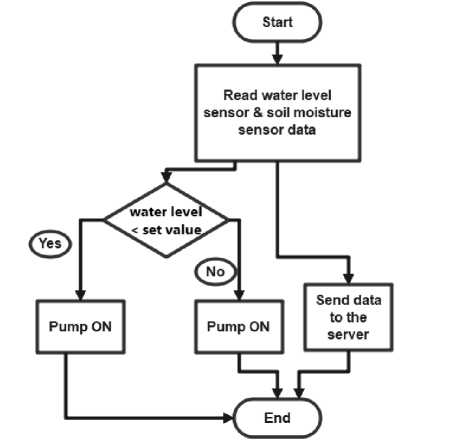
Fig. 3. A Flowchart illustrating the working flow of the client -03.
The LM35 sensor data is read by Client. 2 and transferred to the server (Fig. 4). The server receives the data that the client supplied, and the server then shows the sensor readings on the browser dashboard.
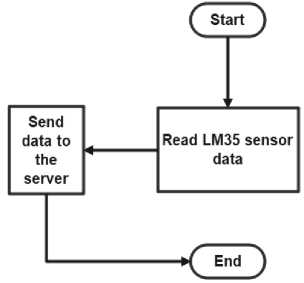
Fig. 4. A Flowchart illustrating the working flow of the Client. 02.
The signal from each client is received in the server portion. The server verifies each client's status individually. It waits for the sensor data from the clients when the client's data isn't accessible. The server broadcasts the sensor data to the web dashboard once client data is available.
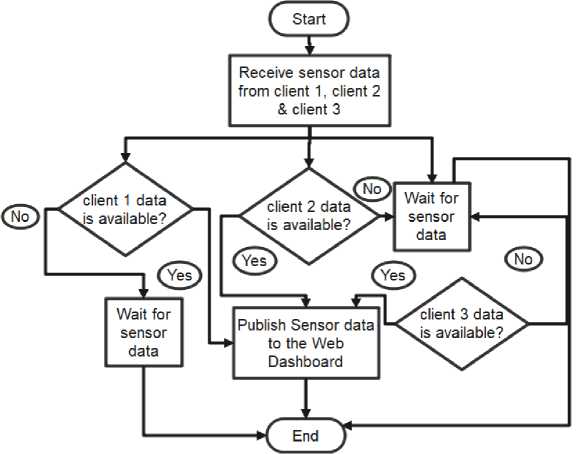
Fig. 5. A Flowchart illustrating the working flow of the server nodes.
-
3.2 Administration Domain
-
3.3 Architectural Overview
The farm's environment's temperature, humidity, air quality, light level, wetness, and water level are all measured and presented in an online dashboard, along with the animals' body temperatures in degrees Celsius and Fahrenheit. By using the online dashboard, farmers and administrators may simply keep an eye on the health of the animals and the farm's surroundings. The farmers can also take the essential actions for the farms and the animals. The monitoring parameters in the dashboard are shown in Fig. 6.
Depending on location, the modules that have been deployed across the farms and animal bodies will be linked together. These clients will all communicate wirelessly to exchange information and transmit it to the main server. A portion of the design will integrate clients and servers. The online dashboard will get all data from the smart farms via a server. The dashboard allows the farmers to continually monitor all the data. The modular architecture of the system lets further client-server units and sensor modules be added to bigger farms. By adjusting the software and adding pertinent sensors as needed, it also provides adaptability to varying farm sizes, environmental conditions, and data thresholds.

Fig. 6. An administration panel web dashboard of the proposed systems.
The online dashboard, as shown in Fig. 7., is ready to display the body temperature of the cow as well as the farm's environment's temperature, humidity, air quality, light level, wetness, and water level after connecting all the modules on the cattle's body and within the farm. We can monitor the farm's environment and the health of the livestock using this dashboard.
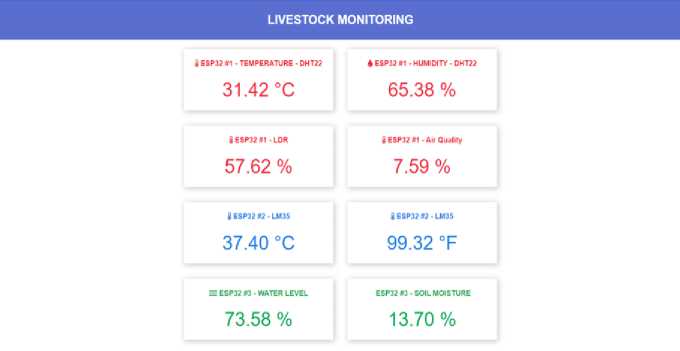
Fig. 7. The online monitoring dashboard of the proposed systems.
The Client. 1, which uses two actuations and three sensors including LDR, DHT22, and MQ135, is shown in Fig. 8.

Fig. 8. The client-01 module of the proposed systems.
Fig. 9. shows the Client. 3 modules that measure dampness and water level and perform actuation.
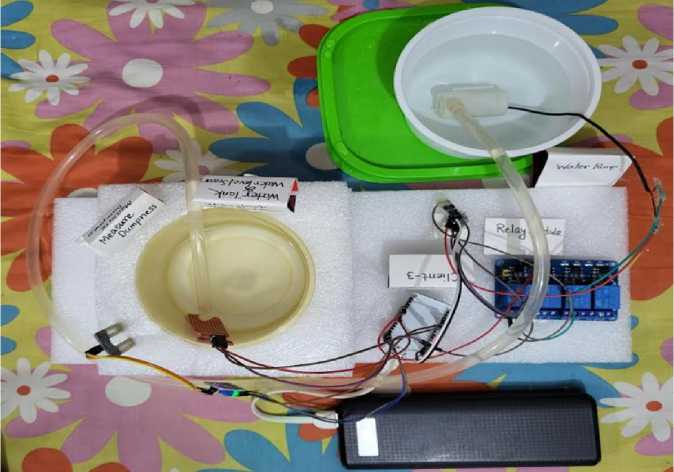
Fig. 9. The client. 3 modules of the proposed systems.
The client. 2 that will be affixed to the animal's body is shown in Fig. 10. It measures the body temperature of the individual cows.
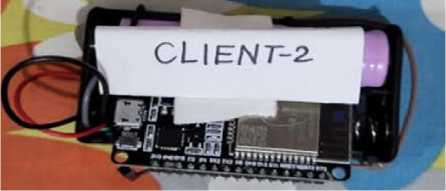
Fig. 10. The module of Client. 2 of the proposed systems
Fig. 11. depicts the server module, which wirelessly receives all data from all clients and presents it on the dashboard.

Fig. 11. The server module of the proposed systems
4. Experimental Result and Discussion
We covered the experimental results from the simulation environment in this part. We presented about the experimental set-up in the beginning. The effectiveness of the suggested system components was then assessed in a variety of environmental conditions. Last but not least, we evaluated the dependability of the system's components that come into touch with the animal's body.
-
4.1 Simulation Environment
-
4.2 Result Analysis
To conduct our tests, we connected various components to the ESP32 board, which functioned as the project microcontroller. After connecting all the component pieces to the ESP32, we upload a script and run it to test the gadget. To program the ESP32, the Arduino IDE software is utilized, and the C programming language is used in the script to operate the sensors. This system is currently a prototype developed primarily for testing purposes, not a fully developed product. The experimental results presented in the manuscript were conducted in a controlled simulation environment to validate the core functionality of the system. We acknowledge that real-world conditions, such as extreme weather and varying farm layouts, could affect the system's performance. Future work will involve field trials to assess the system’s robustness under these conditions.
In this section, we've demonstrated how well our device performs in terms of detecting ambient temperature and humidity, monitoring, and controlling the farm's ambient air quality, monitoring an animal's body temperature in realtime, detecting dampness, ensuring that there is enough clean drinking water available for animals, and calculating the farm's light level.
-
A. Ambient temperature and humidity detection
Cow milk productivity is regarded as the most detrimental impact of heat stress since the economic repercussions are often apparent after a few days. To ensure maximum milk production and livestock health, we must keep these animals at appropriate temperatures and humidity levels. We may regulate the farm's fans and heating components to provide optimal temperatures and humidity for the animals, given the considerable influence that high ambient temperatures and heat waves have on the well-being and production of dairy cows. The temperature and humidity were measured with the DHT21. Continuous temperature and humidity data are available via the internet dashboard. Fig. 5 show how to gather data from a web dashboard.
-
B. Monitoring and regulating the farm's ambient air quality
By releasing gases, including ammonia and hydrogen sulfide, particulate matter, volatile organic compounds, hazardous air pollutants, and odor, dairy activities can impact the air quality. As a result, these contaminants have various detrimental effects on the environment and human health. The recommended technology can monitor the environment's air quality. The air quality value for the PPM parameter can be shown by the system. We regularly checked the value. The system can measure air quality in a variety of environments.
-
C. Tracking the animal's body temperature in real-time
Dairy animals' body temperature is an accurate health indicator. Body temperature changes are frequently the first indicator of an acute disease. Before clinical symptoms appear, a shift in body temperature occurs. As a result, it is critical that temperature be recorded continually and that the course be documented. This is the only way to appropriately identify and understand indicators of sickness at an early stage. To do this, we created a device that can remotely monitor Real Time temperature. The device was built with an LM35 sensor. The device is self-powered and linked to dairy animals' bodies.
-
D. Detecting dampness
A dairy farm's foundation is frequently made of brick or concrete. Because of how quickly it degrades, the animal becomes unwell, reducing milk production. Poor maintenance or condition of concrete flooring in cow barns has been identified as a critical factor associated with increased lameness prevalence. When cows' feet are exposed to dampness, the risk of infectious foot skin diseases and horn erosion remains. Furthermore, all these disorders, including hard and soft feet, foot rods, heel erosions, laminitis, sole ulcers, and digital dermatitis, are caused by dampness on the floor. To achieve the best results from the farms, farmers must manually monitor the dampness of the farm floor. To address the issue, our technology automatically detects the moisture of the farm floor at all times and presents it via the online dashboard. As a result, it will assist farmers in taking appropriate steps based on the floor condition.
-
E. Ensuring sufficient pure drinking water for Animals
After air, water is the second most important nutrient for animals. On the other hand, farmers must handle water quantity and quality in their animal operations. Providing safe and clean water boosts cow milk production and reproductive potential. For cows, clean water is essential for regular digestion, proper feed transit through the digestive system, optimal nutrient absorption, normal blood volume, and tissue requirements. The scarcity of drinking water can result in decreased milk supply and cow reproductive failure. Our system automatically distributes a suitable amount of clean drinking water based on the needs of the animals. In our proposed system, a water level sensor will be installed in each farm's water tank. If the tank's water level falls below a specific level, the sensor will activate the pump, assuring a steady supply of clean, fresh drinking water.
F. Determining the Light level of the farm
5. Conclusion and Future work
Proper lighting in barns ensures optimal cow performance. Farmers who maintain adequate lighting levels in the barn will see a 6–10% increase in milk production. More light is needed to equal natural light levels in barns, especially in the winter. While natural light may be sufficient in the summer, lighting control may still be helpful on cloudy, darker days. Using LDR sensors, this system's planned schedule can provide the farms with the right amount of light.
Additionally, it continually calculates the farm's light level and displays it on the online dashboard so that the farmers can keep an eye on it from a distance.
Table 1. Comparative Analysis of the proposed system with existing state-of-the-art systems
|
Ref |
No. of Sensors Used |
Parameters Considered |
Cattle Health Monitor |
Environment Monitor |
Low-Power |
Productivity Concern |
CostBenefit Concern |
|
[5] |
3 |
yes / yes / no / no / no / no |
yes |
no |
no |
no |
no |
|
[6] |
2 |
yes / yes / no / no / no / no |
yes |
no |
yes |
yes |
yes |
|
[10] |
4 |
yes / no / no / no / no / no |
yes |
no |
no |
no |
no |
|
[11] |
3 |
yes / yes / no / no / no / no |
yes |
no |
yes |
no |
yes |
|
[13] |
3 |
yes / no / no / no / no / no |
yes |
no |
yes |
no |
no |
|
[14] |
2 |
yes / no / no / no / no / no |
yes |
no |
yes |
no |
yes |
|
[21] |
3 |
yes / yes / no / no / no / no |
yes |
no |
no |
no |
no |
|
[22] |
2 |
yes / yes / no / no / no / no |
yes |
no |
no |
no |
no |
|
[26] |
4 |
yes / yes / no / no / no / no |
yes |
no |
no |
no |
yes |
|
[27] |
3 |
yes / yes / no / no / no / no |
yes |
no |
yes |
no |
yes |
|
[28] |
2 |
yes / no / no / no / no / no |
yes |
no |
yes |
no |
yes |
|
[30] |
3 |
yes / yes / no / no / no / no |
yes |
no |
yes |
no |
no |
|
[9] |
5 |
yes / yes / no / yes / no / yes |
yes |
yes |
no |
yes |
no |
|
[8] |
6 |
yes / yes / yes / no / no / yes |
yes |
yes |
no |
no |
yes |
|
Pro posed System |
7 |
yes / yes / yes / yes / yes / yes |
yes |
yes |
yes |
yes |
yes |
Regarding the practical aspects, the proposed system is capable of monitoring more parameters, such as cattle health as well as external environmental conditions like humidity, temperature, and air quality. Also, a large number of monitoring systems in Table 1. are presented in the table, where most of them monitor few parameters, which will need to be done manually. However, the proposed system has integration for providing actions automatically based on realtime data. The advantages of the system include affordability as the proposed system used low-cost sensors (LM35, DHT22, and MQ135), whereas existing systems are more expensive or are less functional. Features of the proposed system include a user-friendly dashboard and remote monitoring, which provides farmers with access to real-time data without needing technical expertise. This is in stark contrast to some existing systems that potentially have a more involved setup process and often rely on specialized know-how to function.
The approach we propose enables automated monitoring of agricultural conditions and cattle health, therefore solving the deficiencies identified in current systems. In contrast to the majority of systems in the literature that prioritize either livestock health or farm environment monitoring, our approach offers a complete integration of both aspects. It monitors vital aspects like humidity, air quality, light intensity, wetness, and water level. In addition, our system integrates low-power components. However, their effectiveness is still constrained by the use of high-power consumption sensors. The proposed system introduces a paradigm shift by substituting high-power components with low-power sensors and microcontrollers, hence achieving energy efficiency and enabling widespread deployment. Furthermore, our approach is completely wireless, guaranteeing that every module has direct connectivity to the server for smooth data transfer. In contrast to previous efforts, our system incorporates automation that ensures the provision of sufficient clean drinking water for cattle, therefore rendering it not only reliable and efficient but also completely automated. This approach guarantees the resolution of productivity concerns and cost-benefit uncertainties, thereby addressing the existing gaps in the literature by providing a comprehensive solution for the integration of farm automation, environmental monitoring, and animal health.

